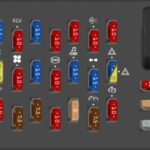The B16 engine, renowned for its performance in Honda vehicles like the Civic Si and Integra Type R, utilizes a specific firing order crucial for optimal operation. While this article doesn’t directly address Rywire’s Mil-Spec engine harnesses, understanding the B16 firing order, especially in OBD2 (On-Board Diagnostics II) equipped vehicles, is essential for diagnostics and troubleshooting. A correct firing order ensures smooth running, efficient power delivery, and minimizes potential engine damage.
Decoding the B16 Firing Order
The B16 engine firing order is 1-3-4-2. This sequence dictates the order in which the spark plugs ignite the air-fuel mixture in each cylinder. Each number corresponds to a specific cylinder:
- 1: Cylinder closest to the timing belt side of the engine.
- 2: Second cylinder from the timing belt side.
- 3: Second cylinder from the transmission side.
- 4: Cylinder closest to the transmission side.
This specific firing order is designed to balance the engine’s power pulses and minimize vibrations. It’s crucial for proper engine timing and efficient combustion.
OBD2 and the B16 Firing Order
OBD2 systems, standard in most vehicles manufactured after 1996, play a vital role in monitoring engine performance and emissions. Although the OBD2 system doesn’t directly control the firing order, it can detect misfires caused by an incorrect firing order or related issues like faulty spark plugs, ignition coils, or wiring.
A misfire occurs when the air-fuel mixture in a cylinder fails to ignite properly. The OBD2 system will detect this and trigger a diagnostic trouble code (DTC), often a P0300 series code (e.g., P0301 for a misfire in cylinder 1). This allows technicians to pinpoint the problem cylinder and diagnose the root cause, which could be related to the firing order, albeit indirectly. Using an OBD2 scanner can provide valuable data for troubleshooting B16 engine performance problems.
Importance of Correct Firing Order
Maintaining the correct firing order is paramount for several reasons:
- Engine Performance: A correct firing order ensures efficient combustion, leading to optimal power output and fuel economy.
- Engine Smoothness: The 1-3-4-2 firing order is designed to balance the engine’s forces, resulting in smoother operation and reduced vibrations.
- Component Longevity: An incorrect firing order can put undue stress on engine components, potentially leading to premature wear and tear.
- Emissions Control: Proper combustion, facilitated by the correct firing order, minimizes harmful emissions and helps the vehicle comply with environmental regulations.
Troubleshooting Potential Issues
While Rywire’s harnesses are designed for quality and reliability, issues can still arise. If you suspect a problem with your B16 engine’s ignition system, even with a new harness, consider these troubleshooting steps:
- Check for DTCs: Use an OBD2 scanner to retrieve any stored trouble codes. These codes provide valuable clues about potential problems.
- Inspect Spark Plugs and Wires: Ensure spark plugs are in good condition and wires are properly connected.
- Verify Ignition Coil Operation: Test ignition coils to ensure they are functioning correctly.
- Consult a Professional: If you’re unable to diagnose the issue, consult a qualified mechanic with experience in Honda B-series engines.
Conclusion
Understanding the B16 firing order is fundamental for anyone working on or diagnosing these powerful Honda engines. While a quality wiring harness like those offered by Rywire is essential, knowing the 1-3-4-2 sequence and its importance in conjunction with OBD2 diagnostics will enable you to keep your B16 running smoothly and efficiently. A correctly functioning ignition system, adhering to the proper firing order, is the key to unlocking the B16’s renowned performance potential.

